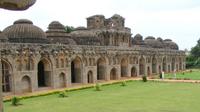 Hampi
HampiThe ruined city of Vijayanagar (the City of Victory), now called Hampi, was established in 1343 on the banks of the River Tungabhadra, a location long considered sacred by Hindus. Between the 14th and 16th centuries, this was the most powerful Hindu capital in the Deccan Plateau. Travelers were astonished by its size and wealth, with markets (bazaars) full of silk, horses, spices and precious gems, ornate palaces and joyous festivities. In 1565 the dazzling city was devastated by a six-month Muslim siege. Everything made of wood was burned, and only stone, brick and stucco structures survived.
As we arrived, we were inundated with licensed tour guides who wanted to offer their services to tour the ruins. We settled on Hussein, a knowledgeable young man who spent three hours with us and began with a brief history of the area to set the stage for what we were about to see. There is still one functioning temple dedicated to a local form of Shiva, the Virupaksha temple. Hussein acquainted us with the meanings and stories of many of the pictures carved in the pillars and on the ceilings. One quick picture story: We see the shadows on the moon as the man in the moon; they see a rabbit.
 Here are brief descriptions of four impressive, still fairly intact, buildings in Hampi. The 56 stone pillars in the Music Temple were constructed to sound the notes of the musical scale when struck with fingers and they still ring! Some make sounds like drums, others make sounds like stringed instruments, and more. It’s amazing!
Here are brief descriptions of four impressive, still fairly intact, buildings in Hampi. The 56 stone pillars in the Music Temple were constructed to sound the notes of the musical scale when struck with fingers and they still ring! Some make sounds like drums, others make sounds like stringed instruments, and more. It’s amazing!  The pillars are covered with dancing figures.
The pillars are covered with dancing figures.The beautiful two-story Lotus Mahal (the archways were designed to look like lotus blossoms) was designed for the pleasure of the queen; a place where she could relax. A moat surrounding the building is thought to have provided water-cooled air via tubes (the first A/C!)
 There was a separate Queen’s bath, 15 meters square, still intact, and open to the sky. Surrounded by corridors with 24 different domes, women from the royal household would bathe here and umbrellas were placed in shafts in the tank floor to protect them from the sun.
There was a separate Queen’s bath, 15 meters square, still intact, and open to the sky. Surrounded by corridors with 24 different domes, women from the royal household would bathe here and umbrellas were placed in shafts in the tank floor to protect them from the sun. The elephant stable is a series of 11 high-ceilinged, domed chambers, entered through arches. Only the royal elephants were housed there. (This would be the modern-day equivalent of having an 11-bay garage full of Lexuses, Mercedes' and BMWs!) The capped upper level may have been used by the musicians who accompanied the royal elephant processions. All in all, there was so much to see and learn!
The elephant stable is a series of 11 high-ceilinged, domed chambers, entered through arches. Only the royal elephants were housed there. (This would be the modern-day equivalent of having an 11-bay garage full of Lexuses, Mercedes' and BMWs!) The capped upper level may have been used by the musicians who accompanied the royal elephant processions. All in all, there was so much to see and learn!Here, as in many places, there is a tier system for admission. To enter the temples, Indian citizens pay five rupees, about 12 cents. All others (and it’s obvious who you are!) pay Rs. 215 ($5), still a deal by American standards for entrance admission fees to museums and historic sites.

0 Comments:
Post a Comment
<< Home